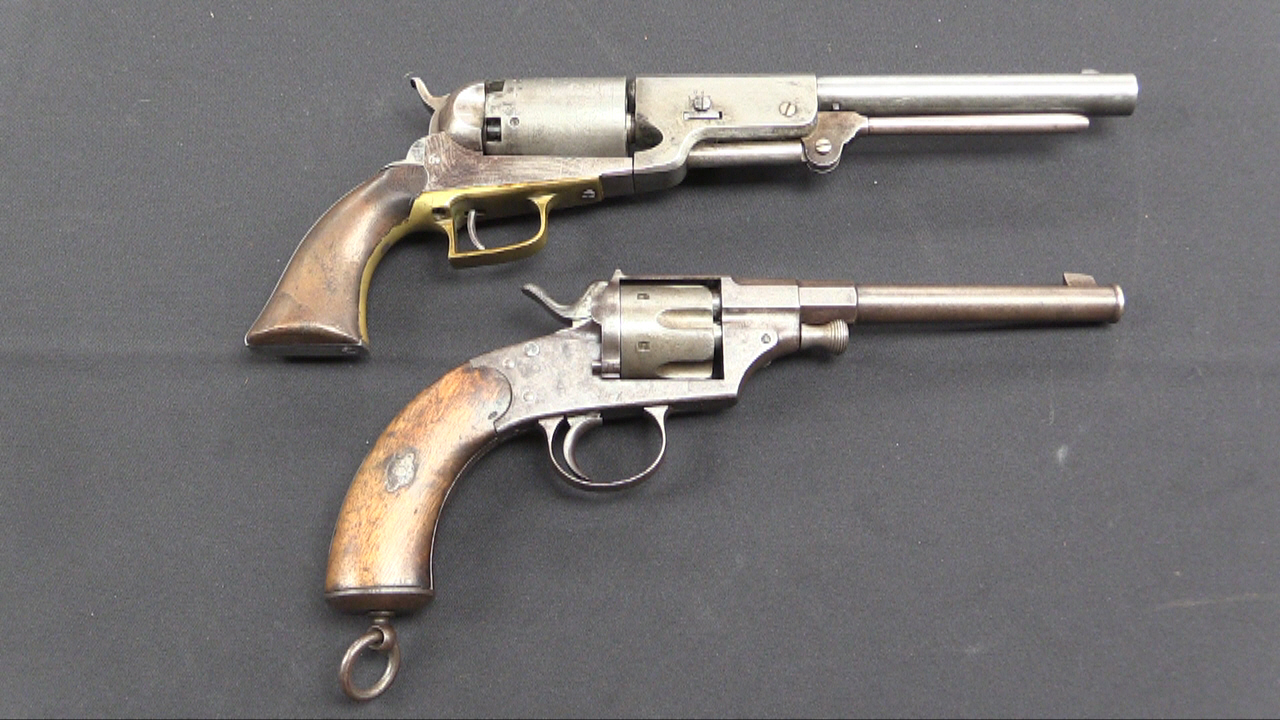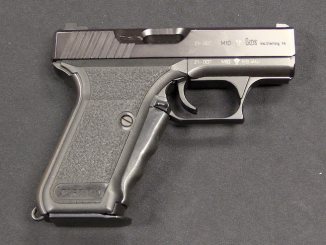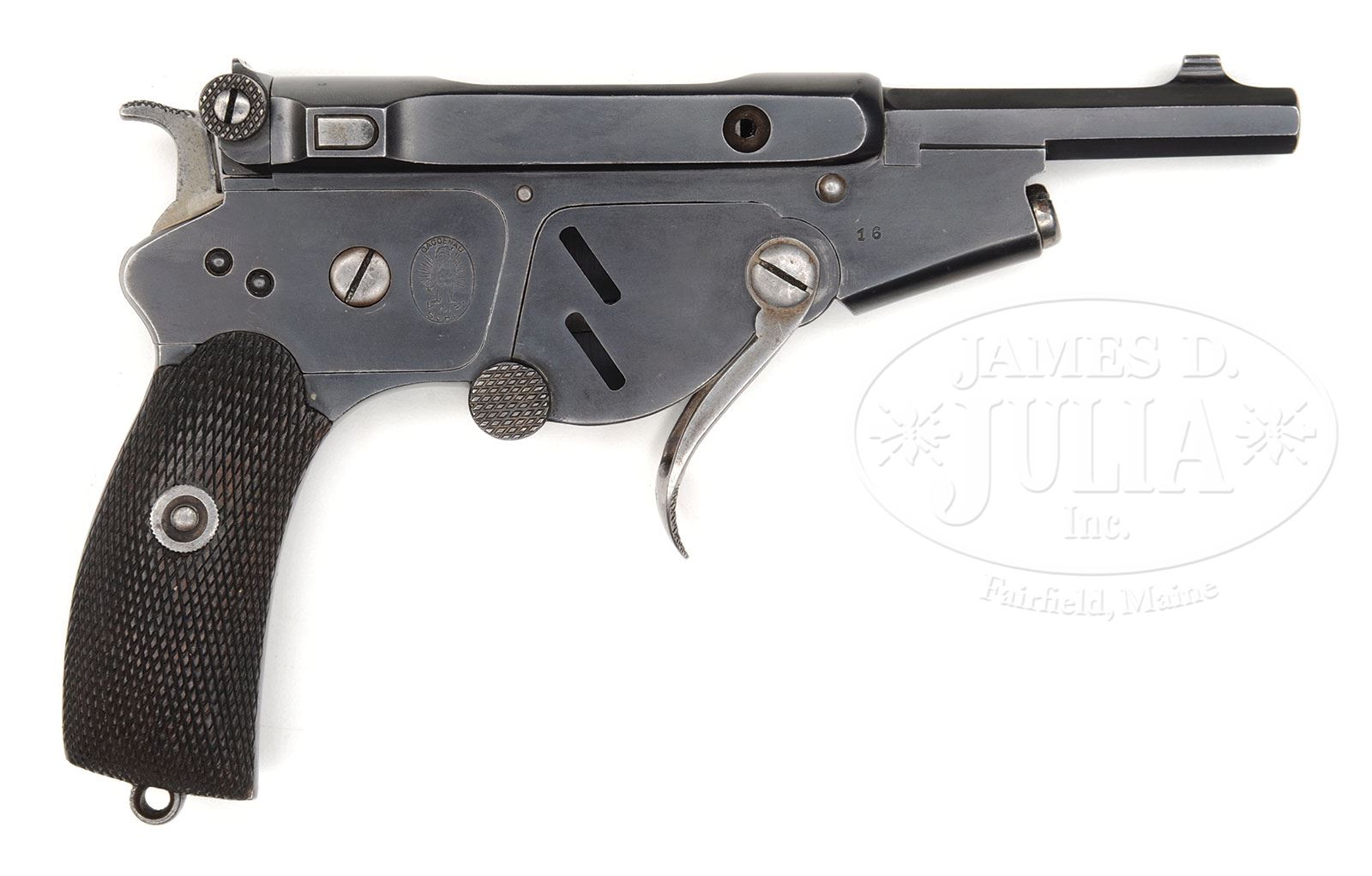The Walther KPK was a modified version of the PPK automatic pistol made in very small numbers by Walther in hopes of winning a new military contract. Mechanically identical to the PPK, the KPK has a lengthened slide to effectively shroud the hammer, preventing it from catching or snagging on clothing or obstacles in the confines of an aircraft or armored vehicle.
Not very much is written about these pistols, and they never went into production (it appears they were made in hopes of spurring a military interest, rather than in response to a military RFP).




Walther may have come up with the KPK because they noticed that the Mauser HsC was popular with both officers and other ranks in the Wehrmacht and Luftwaffe. Because its smooth contours and barely-protruding hammer spur made it very easy to get out of a holster, or a coat pocket, in a hurry.
About the same time, they prototyped a version of the PP in 9×18 “Ultra”, to a RLM RFP for a compact handgun for Luftwaffe aircrews that had more power than the 7.65 or 9mm Kurz versions. It can be distinguished from the 1970s-era “PP Super” in 9×18 because it has a shortened slide group and a longer barrel, the exposed part of which looked a lot like the barrel of a P.08 or P.38. (There’s an exploded diagram of it on p. 675 of Ezell’s Handguns Of The World.)
This pistol might have been made “on spec” as an alternative to that, as well.
cheers
eon
I have always wondered why the Luftwaffe even bothered to try and improve the service pistol of the airmen. If a downed aircrew confronts enemy soldiers, it does not matter what pistol you have. If you can’t escape, you’re either dead or a POW. For intimidating civil population it does not matter what the properties of the pistol are; 7.65mm or 9mm Browning will work as well as 9mm Ultra. At least they had the sense of finally not adopting the 9mm Ultra, since it made no military sense and would have just added another caliber to the mix.
Part of the reason may have been the rivalry between services, especially when commanded by such ego-maniacs as Goering.
Andrzej
The first thing I noticed was the safety, or rather the lack thereof.
I’m half surprised they never made that for the commercial market, considering their commercial sales of the PPK and its enduring popularity.
A slide made to those specs would be an interesting aftermarket accessory…
it almost never works out well when a company does this. tries to spontaneously invent “the next big thing”, see google glasses.
The following is not a canonical scene from any James Bond movie:
“Since you’ve run out of tricks, you die, Mr. Bond-!” WHISHACK-THUNK. Bond’s hidden weapon comes out of his overcoat sleeve, guided into his hand by a faked “nervous arm clenching habit” to a spring-loaded deployment device with rails. The spy finishes off the overconfident goon with a few more suppressed shots to the face after having hit him pointblank in the liver.
“I had one ace up my sleeve.”
I could imagine James Bond carrying something like this. Spies wouldn’t want their pistols snagging on their clothes, would they? Could anyone suggest a better way to deploy or un-holster a KPK?
Well, for one there’s this;
http://media.liveauctiongroup.net/i/9633/10496887_3.jpg?v=8CDC9548E93E180
It doesn’t require a suspiciously bulky overcoat; 007 could hide it under his usual suit jacket.
Note that the “built up” slide rear of the KPK makes it less likely that the hammer would snag on the jacket lining when it operates. Add a brass-catcher on the inside of the belt mount, and you could probably fire off the whole magazine without it hanging up.
It’s going to ruin your suit though, guaranteed.
cheers
eon
I am a big fan of the Mauser HsC, having both wartime and postwar models. My postwar .380 has ridden in my jacket pocket quite often on trips to corner grocery or the po-boy shop when I lived in New Orleans. I still find it to be an almost perfect carry piece in a handwarmer pocket for a late night excursion when I am in the city, as it slides in and out with no hangups…and it looks good doing it. 🙂 My Walthers tend to be a bit more “snag-prone” when carried in the same manner, as the pocket lining often drapes around the pointy bits. This Walther KPK looks like an attempt to give the PPK a more “carry-friendly” shape, but it just doesn’t seem to have the inherent “smoothness” of the Mauser design. I still like my PPKs, but, having carried both, the HsC gets the nod (along with the HK P7).
“I am a big fan of the Mauser HsC”
If the Walther PPK and Mauser HSc was mentioned don’t forget about Sauer 38H – another .32 Auto German pocket automatic pistol – so far I know first mass produced automatic pistol featuring the cocking/decocking lever.
My Sauer 38H (.32 ACP) is a wartime model with the phosphate finish, and is also a great design, even though the finish is not up to pre-war (or post-war) standards. Although suitable as a defensive sidearm, I try to avoid carrying anything “historical” just in case I would have to use it and subsequently have to hand it over to the police. I’d rather lose something more replaceable than an historical artifact.
I’d really like to add a Sauer 38H to my collection, and I consider it quite unfortunate that Sauer didn’t keep making them after the war. I’d like one in .380, but as far as I can tell no such thing exists.
In war and field conditions, “Dust or dirt proof” guns should be more important than “Snag free” ones. If that pistol was made during 1940 era which other samples like Mauser HSc, Sauer H, Walther P38 were present, all had measures to prevent dust, sand like small particles to enter inside the gun. Hammerless construction of Sauer H, small spur with sweeping hammer contours of HSc, dust cover of slide over lock uppers and even folders on the press formed triggers of P38 were all to realize that purpose. Small particles with aid of excess oil and humidity were big troubles for guns and snag free features for pistols to be carried in a holster looks very Holywoood style for that time. Simply cutting out the hammer ring would provide more snag and dust free features than closing the sides in uncocked mode and creating more area for dirt collection. Besides, why that pistol has not a safety. It may remain cocked being as very dangerous within a tank or aircraft and more snagcatching than plain PPK. Users could not be very coolblooded at every conditions to recock a gun manually. What “KPK” stands for. Furthermore, prototypes made other than one, should have marks to identify to each other. Is there any other sample of that gun. Frankly, this pistol seems made by a gunbuff with a workshop rather than being a gun manufacturer of seven decades of past.
Search in the net shows another pistol of same “KPK” identification but somewhat similar and more functional and durable shape. Accordingly; “K” stands for “Krieg or Kampf”, trigger is SA only with a limiter pin ahead of its axis pin restricting its forwards unnecessary travel, slide shroud is smaller, grips are not wrap-around for more durable against to possible strikes within crafts, magazine catch at underside, heel type for securer hold and having a safety lever at where usual magazine catch button of PP’s locates, as a downsidely working lever. It sounds and looks more keen minded. No additional identification marks either. Site; http://www.icollector.com
Gun had been sold by RIA at Dec. 03, 2011.
i have an old verry rare document for you, it’s a scan of a photocopy of an old french gun magazine (1996/1999 ?)
http://img4.hostingpics.net/pics/515872forgottensturmgewehr.jpg
I posted a question on the Weaponsman blog about what K in “PPK” actually stands for, but didn’t really get an explanation. Tradition has it that it stands for Polizei Pistole Kriminalpolizei (KriPo), of course. But the K in every other shortened German firearm stands for “kurz”, right? Does anyone have any contemporary Walther literature from the 1930s that definitely states what it stands for?
As Strongarm mentioned, if the first K in “KPK” stands for Krieg or Kampf, what does the rest stand for? Kriegsmodell Pistole Kriminalpolizei doesn’t make much sense to me, but maybe it does to a German-speaker.
As it happens, German Wikipedia tells us:
“Die Modellbezeichnung „PPK“ steht für Polizeipistole Kriminal*. Die fälschliche Bezeichnung „Polizeipistole kurz“ ist jedoch so weit verbreitet, dass selbst der Hersteller sie teilweise verwendet.”
Rough translation:
“The designation “PPK” stands for “Polizeipistole Kriminal”. The incorrect designation “Polizeipistole kurz” is, however, so common that even the manufacturer sometimes uses it.”
As for what PKP might stand for, I have no clue. “Kampfpistole Kriminal” does not make sense, but “Kampfpistole kurz” would, at least somewhat.
* It is not necessary to repeat “Polizei” since the context tells a German reader that “Kriminal” means “Detective”, not “Criminal”…
Cheers Euroweasel! I wonder how the nomenclature can be incorrect if even the manufacturer sometimes uses it, though? Do they give a source?
No, unfortunately they don’t for “kurz” being used by the manufacturer. So perhaps the guy who wrote that remembers it wrong. It’s still possible that it may have appeared in some Walther brochures or other marketing material by accident at one time or another.